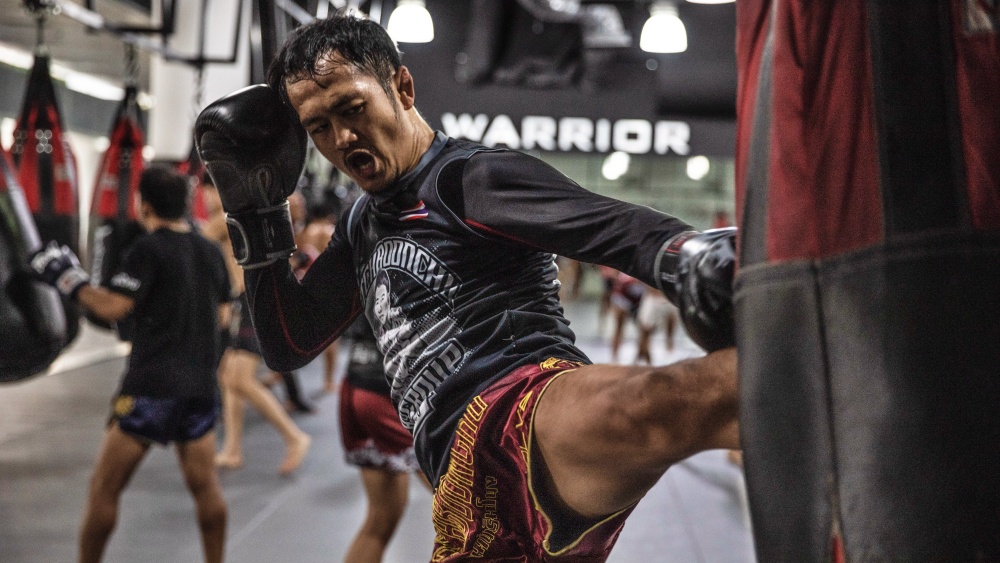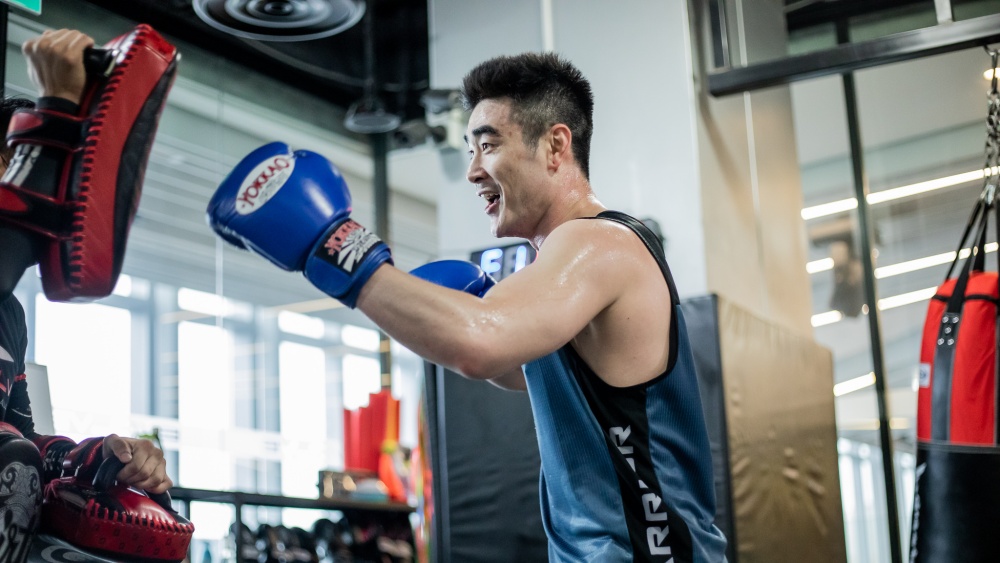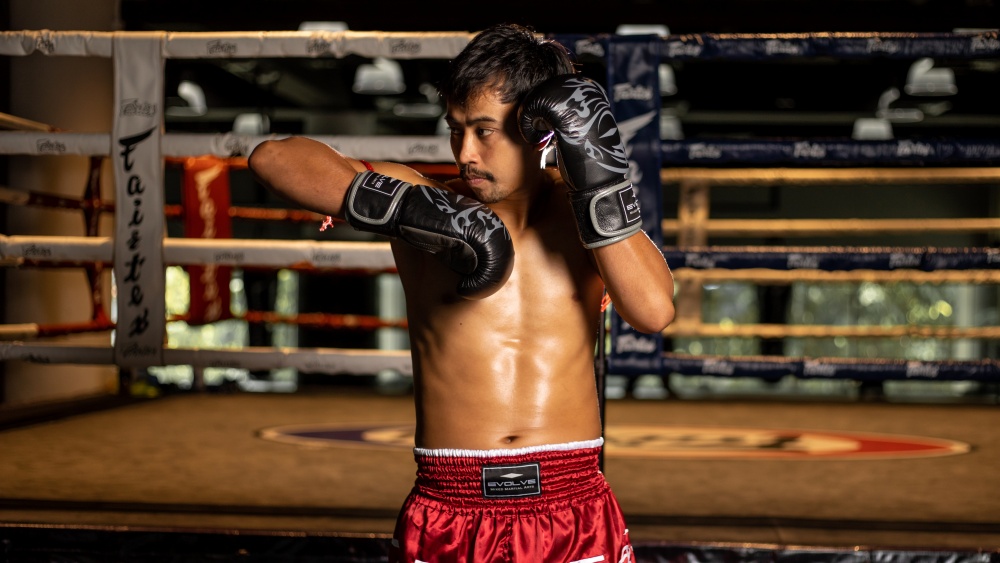Muay Thai is a martial art form that has grown in popularity and is practiced all over the world. Its origins are rooted in military use, and the sport maintains a deep sense of culture and community. As the national sport of Thailand, it is an incredibly thrilling sport for all involved, including athletes, coaches, and spectators.
Muay Thai has become a go-to martial art for practical self-defense skills, making it the chosen martial art for all ages and genders – young, old, male, and female. Muay Thai is easily one of the most recognizable martial arts, with a reputation for practical use in various areas, including self-defense, health-related pursuits, and the integration for MMA fighters alike.
The Art Of 8 Limbs
Muay Thai is a martial art known by the nickname, “The Art of 8 Limbs”. This nickname encompasses the striking aspects of the sport, which include punches, elbows, knees, and kicks.
The inclusion of both upper and lower body striking makes for an intriguing, fast-paced, and powerful sport. Athletes can use any of the eight strikes, in any combination of their choosing, and can place their strikes at any part of their opponent’s body, including the legs, body, and head.
In addition to the striking that is utilized by the 8 Limbs, Muay Thai involves the use of the clinch and sweeps.
- Clinch: The clinch enables athletes to grab on to and control the posture of their opponent’s head, which often opens the door to landing knees, elbows, and even sweeps.
- Sweeps: Sweeps, at their core, are essentially knocking your opponent down to the ground, often through the use of “sweeping” out their feet from beneath them.
The Art of 8 Limbs is a full-bodied martial art. It allows for strikes stemming from all 8 limbs of the body, as well as the clinch and sweeps that are always thrilling to watch. With these, fighters can put together a fighting style that is quite unique and based on their preferences for striking and range.
Where Did Muay Thai Originate?
Muay Thai was born in Thailand hundreds of years ago as a method for the Thai army to utilize for fighting, combat, and self-defense. The Art of 8 Limbs allowed for a highly effective and practical combative set.
As Rama V took over the throne in Thailand in 1868, Muay Thai as a sport rapidly began to grow and thrive, thanks to his own personal interest in the sport propelling it forward. While the country was at peace, Muay Thai continued to thrive as a celebratory activity and health-related pursuit, as it then began its transformation into the sport we now know and love.
Over time, Muay Thai began to adopt rule sets, specific gear usage, and time limits for rounds, leading it to develop into the more standardized sport we see today.
While Muay Thai has its roots and origin in Thailand, Muay Thai has now spread throughout the world. Today, it is practiced by men, women, and children of all ages as a martial art for self-defense, as well as for general health and fitness. Many others participate with the intent to compete in matches and fights. What once began in Thailand alone is now a sport enjoyed and practiced by many worldwide.
Who Is Muay Thai For?
Muay Thai is for everyone. It is a sport that is open to those who dream of fighting one day, as well as those looking for some practical self-defense skills or to hone in on some health-related goals. As such, it is not uncommon to see whole families training together. Muay Thai gyms often have classes for children based on ages and skill levels, inviting even the smallest of athletes to join in and learn Muay Thai.
What Do Muay Thai Athletes Wear?
Athletes who fight in a Muay Thai match must wear specific gear. Some gear is for their protection, and other gear functions as more of a traditional, decorative, or cultural and respectful aspect to their clothing.
- Gloves: Athletes wear padded gloves. Depending on the promotion, athletes may be required to wear specific gloves, but regardless, gloves are required for Muay Thai fights.
- Mouthguard: A mouthguard is required for all matches and is for the safety of the fighter.
- Muay Thai Shorts: Muay Thai shorts are the standard uniform for Muay Thai fights. These shorts are shorter in length to allow for freely moving through kicks. They are often vibrant in color and quite flashy and fun in design. Female fighters will additionally wear a top of some sort, based on requirements by the promotion.
- Ankle Guards: While not typically required for a fight, you will often see many fighters utilize ankle guards during a match.
- Mongkhon: This traditional item is worn on the head of the fighter. It is believed to pass good luck and give protection to its wearer. These are blessed by monks and passed down within individual camps. Unlike other gear items, the Mongkhon is removed before the match begins.
- Pra Jiad: These traditional armbands are also believed to bring good luck to the fighter wearing them. They are more of a traditional and cultural item for wear during a match. Fighters will wear these on their arms throughout their fights.
Muay Thai athletes wear both their practical gear, as well as their traditional and cultural gear for each fight.
Are There Weight Classes In Muay Thai?
Muay Thai matches are put together according to weight classes, although various organizations may have some slight differences in weight classes and weight ranges. Many athletes strive to win belts and become champions across multiple weight classes, rather than sticking to dominating just one weight class.
Athletes are required to weigh in before a match and meet the pre-determined weight class requirements agreed upon for the particular match. Athletes can go up a weight class, but they cannot fight down a weight class.
What Does A Muay Thai Match Look Like?
Today, Muay Thai matches are fairly standardized. There are typically differences among various promotions and organizations, but standards are always set and known ahead of a match. Variations for round time, rest time between rounds, or even the number of rounds might vary based on the promotion, the level of fighter (amateur, professional, etc.), or any other pertinent factors. Weight classes are also utilized for all Muay Thai fights.
Regardless, all expectations and rule sets are set ahead of a match and agreed to by the fighters and their coaches. Fights take place within a ring, with roped sides indicating the space in which fighters can utilize for the match.
A Muay Thai fight will include the fighters, their coaches (and cornermen), and the referee in the middle of the ring. Additionally, there will be three judges sitting ringside to score the match. Points will be awarded throughout the match and athletes are held to a standard of mutual respect and following the rules. While strikes are essentially allowed anywhere on the body, groin shots are not allowed and will be penalized if found to be an intentional act.
When the round bell rings, all fighting must stop and the fighters are expected to disengage and head to their corners immediately. It’s not uncommon to see fighters hug or show respect in some way towards each other at the end of the round. Muay Thai is truly a sport that embodies respect among athletes.
At the end of the match, a winner will be chosen based on the points scored. The only time a match will not make it to the end of the rounds is when one fighter knocks the other out. If a knockout occurs, the match is immediately over, regardless of how much time has (or hasn’t) passed in the match. After the winner’s hand is raised, it is, once again, typical to see fighters hug, shake hands, or show some other form of respect and thanks to one another.
How Does Muay Thai Scoring Work?
Scoring is quite simple during a Muay Thai match. Points are awarded based on strikes landed. All 8 Limbs are open for landing and scoring points (punches, elbows, knees, and any type of kick). Points are not awarded if a strike is blocked by the opponent. Strikes must land cleanly on the opponent’s body to count for points.
The way strikes are delivered is also of significance for the scorecard. A strike that barely touches the opponent is not going to score as well as a strike that causes the opponent to stumble back to catch their balance. Dominance in the ring is of utmost importance in a Muay Thai match, and landing significant strikes is an integral part of that.
Muay Thai fights typically have three judges responsible for the scoring and the choosing of the winner. They will watch the fight closely and award the winner based on significant strikes, damage caused to the opponent through those strikes, ring control, and dominance over their opponent. All of these things paint the larger picture of the match, allowing judges to score and determine a winner at the end.
What Is The Wai Kru Ram Muay?
As athletes make their way to the ring for the match, they will begin the Wai Kru Ram Muay. This traditional dance ritual is broken into two parts, the Wai Kru, and the Ram Muay. Fighters continue to wear their Mongkols throughout this ritual, as they pay their respects and give honor to their coaches, teammates, family, and even their gym as a whole.
- Wai Kru: The Wai Kru portion of this ceremonial ritual is marked by the fighter circling the ring counterclockwise. The fighter will pause briefly at each corner to say a prayer.
- Ram Muay: The Ram Muay begins as soon as the Wai Kru ends, and is performed alongside traditional, unique Thai music. This beautiful dance is passed down through Muay Thai gyms and coaches, and the uniqueness of each Ram Muay is a beautiful display of culture and tradition. The Ram Muay also provides an opportunity for the individual fighter to display their style and control over their own body while they dance.
The Wai Kru Ram Muay is an important cultural piece that brings uniqueness to a Muay Thai fight. This ritual prayer and dance is also an exciting and beautiful artistic expression that engages and begins to draw in the spectators before the match itself even begins.
Muay Thai: The Ultimate Martial Art

Muay Thai is for everyone, regardless of age or skill level. Evolve MMA offers Muay Thai classes for all ages, catering to beginners and advanced practitioners alike.
There’s no doubt about it; Muay Thai is a sport that offers something for everyone. Regardless of your goals, Muay Thai will help you to learn new things, push yourself beyond your limits, and give you an incredible community to support you as you learn.
- Spectators enjoy the fast-paced and highly practical nature of the matches, as well as the beauty and culture that are displayed at the beginning during the Wai Kru Ram Muay.
- Families enjoy the ability to share the sport as they all train and grow together.
- Athletes appreciate the competition side of the sport, as well as all the various organizations that allow even the most novice of fighters to compete and learn.
- Everyone who trains gains and appreciates the knowledge of how to practically and effectively defend themselves using Muay Thai.
What once began as a way to protect and defend a country has developed into a sport that has televised matches regularly aired around the world. Amazingly, the sport has managed to maintain a great deal of its cultural heritage through the use of the items donned by athletes in the ring and with the war dance performed before the matches. The combination of the practical sport paired with the beauty of its cultural heritage makes for a fascinatingly unique sport.
Give Muay Thai A Try
Wondering what a Muay Thai class looks like? Attend one of Evolve MMA’s complimentary introductory Muay Thai classes to find out.
Book your complimentary trial class with our World Champions below!
If you have any other questions regarding Evolve MMA and the programs we offer, you can get in touch with our membership executives at the following locations:
Evolve MMA (Far East Square)
26 China Street
Far East Square #01-01
Singapore 049568
Phone: (65) 6536 4525
Evolve MMA (Orchard Central)
181 Orchard Road
#06-01 Orchard Central
Singapore 238896
Phone: (65) 6536 4556
Evolve MMA (KINEX)
11 Tanjong Katong Road
#02-52 KINEX
Singapore 437157
Phone: (65) 6288 2293
Evolve MMA (Clarke Quay Central)
6 Eu Tong Sen Street
#04-18 Clarke Quay Central
Singapore 059817
Phone: (65) 6226 2150
Evolve MMA (Star Vista)
1 Vista Exchange Green
#02-26A The Star Vista
Singapore 138617
Phone: (65) 6539 9590



















